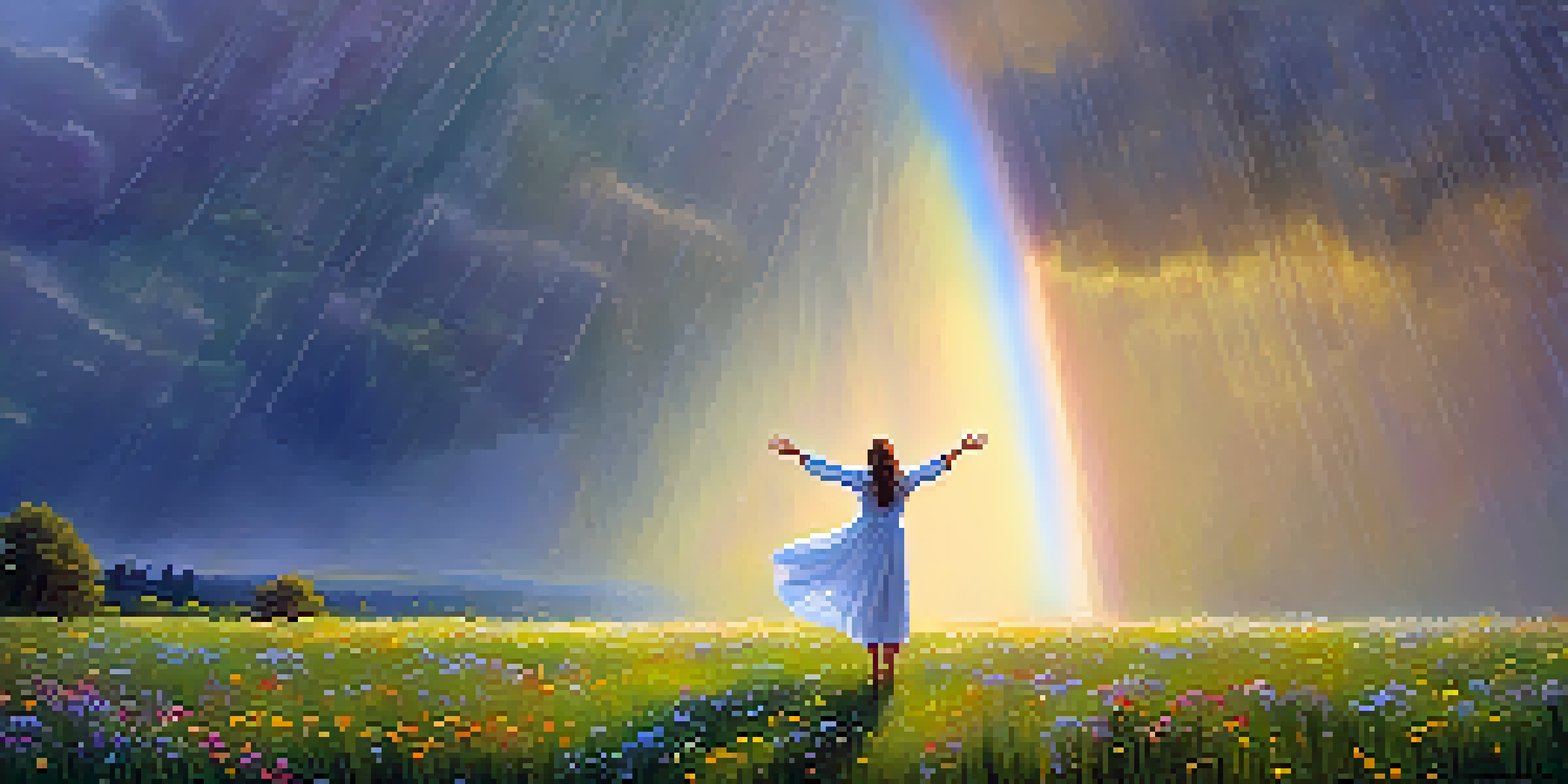Rituals in the Rain: Spiritual Practices Inspired by Weather

The Connection Between Weather and Spirituality
Weather has always held a special place in human spirituality. From ancient times, people have observed natural phenomena and attributed deeper meanings to them. Rain, in particular, symbolizes renewal and cleansing, making it a popular theme in various spiritual practices.
The clearest way into the Universe is through a forest wilderness.
For many cultures, the sight of dark clouds and the sound of thunder evoke a sense of awe and reverence. This connection often leads to rituals that honor the elements, reflecting humanity's intrinsic bond with nature. By recognizing weather's spiritual significance, we foster a deeper appreciation for the world around us.
As we explore these practices, it's essential to understand that embracing weather in spirituality can deepen our personal connections to the earth. It encourages mindfulness and helps us find meaning in the natural cycles that govern our lives.
Rain Rituals: Cleansing and Renewal
Rain has long been associated with cleansing, both physically and spiritually. Many cultures perform rituals during or after rain to symbolize purification and renewal. For example, some Indigenous tribes celebrate rain with dances and songs that express gratitude for the life-giving water.

These rituals often involve gathering in nature, allowing participants to feel the rain on their skin as a form of baptism. This physical connection to the elements serves as a reminder of our place in the natural world and the importance of respecting it.
Weather's Spiritual Significance
Various cultures have long connected weather phenomena, like rain and sunshine, to spiritual practices that reflect renewal, gratitude, and community.
Moreover, rain rituals can also serve as a metaphor for emotional release. Just as rain washes away dirt, these practices encourage individuals to let go of negativity and embrace a fresh start, making way for personal growth and healing.
Sunshine and Celebration: Festivals of Light
Just as rain rituals focus on cleansing, sunshine celebrations often emphasize joy and abundance. Many cultures hold festivals to honor the sun, recognizing its essential role in life. These events are filled with music, dance, and communal feasting, celebrating the warmth and light the sun brings.
Nature does not hurry, yet everything is accomplished.
For instance, the Summer Solstice is celebrated in various cultures as a time of gratitude for the sun's energy. People gather to perform rituals, such as lighting bonfires or sharing meals, to honor the longest day of the year. This collective joy fosters a sense of community and connection.
Moreover, these festivals serve as a reminder of the cycles of life. Just as the sun rises and sets, so too do our lives ebb and flow, and these celebrations encourage participants to appreciate both the light and dark moments.
Wind and Breath: Finding Spiritual Guidance
Wind is often seen as a messenger in many spiritual traditions. It carries sounds, scents, and changes in weather, making it a powerful symbol of change and transformation. Practicing mindfulness in the presence of wind can help individuals connect with their inner selves and the universe.
In some cultures, rituals involving wind may include meditation or breathwork, focusing on the flow of air and the sensations it brings. This practice can help ground participants, allowing them to reflect on their thoughts and emotions.
Rituals for Cleansing and Growth
Rain rituals symbolize purification and emotional release, while sunshine celebrations focus on joy and abundance, reinforcing the cycles of life.
Additionally, the wind can serve as a reminder to go with the flow of life. Just as the wind changes direction, our lives are subject to unexpected shifts. Embracing this idea can foster resilience and adaptability in the face of challenges.
Thunder and Lightning: The Power of the Storm
Thunder and lightning often evoke feelings of fear and respect, reminding us of nature's raw power. In spiritual practices, storms can be seen as a call for introspection and transformation. Many cultures view thunderstorms as a time to reflect on personal challenges and seek guidance.
During a storm, rituals may include meditation or journaling, allowing individuals to confront their fears and uncertainties. This practice can lead to profound insights and foster a sense of empowerment as participants learn to navigate life's storms.
Furthermore, thunderstorms can symbolize the breaking of old patterns. Just as a storm clears the air, these rituals encourage letting go of limiting beliefs, making way for new growth and opportunities.
Seasonal Changes: Embracing Nature's Cycles
Seasons play a vital role in spiritual practices, reflecting the cyclical nature of life. Each season brings unique weather patterns and natural phenomena, offering opportunities for rituals that honor these changes. For example, spring is often associated with rebirth and renewal, while autumn signifies gratitude and reflection.
By aligning our spiritual practices with seasonal changes, we cultivate a deeper connection to nature and its rhythms. This alignment can enhance our awareness of the passage of time and the importance of living in harmony with our surroundings.
Personalizing Weather Rituals
Creating your own weather-inspired rituals allows for a deeper spiritual connection and personal growth through mindfulness and reflection.
Moreover, seasonal rituals provide a sense of community, as people gather to celebrate and honor these natural cycles together. This shared experience fosters connection and strengthens bonds among participants, creating a nurturing environment.
Weather and Meditation: Finding Inner Peace
Meditation practices inspired by weather phenomena can help individuals cultivate inner peace. By focusing on the sounds of rain, the warmth of the sun, or the gentle breeze, practitioners can create a serene atmosphere that promotes mindfulness and relaxation. These elements of nature serve as anchors for meditation, helping to quiet the mind.
Incorporating weather into meditation can also enhance the experience by creating a multisensory environment. For example, meditating with the sound of rain can evoke feelings of calm and tranquility, while the warmth of the sun can inspire feelings of joy and gratitude.

Additionally, weather-inspired meditation helps us appreciate the present moment. By tuning into the natural world, we can cultivate a sense of connection to the earth and gain clarity on our thoughts and emotions.
Personalizing Your Weather-Inspired Rituals
Creating your own weather-inspired rituals can deepen your spiritual practice and foster a stronger connection to nature. Start by observing the weather around you and reflecting on how it makes you feel. This awareness can help you design rituals that resonate with your personal experiences.
For example, you might choose to meditate during a rainstorm, write in a journal on sunny days, or perform a grounding exercise in the wind. Tailoring these practices to your preferences allows you to create meaningful experiences that align with your unique spiritual journey.
Ultimately, the key is to be open and flexible. Weather is unpredictable, and embracing that uncertainty can lead to beautiful moments of discovery and growth in your spiritual practice.